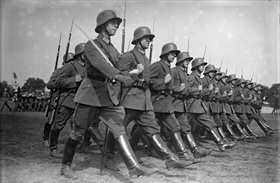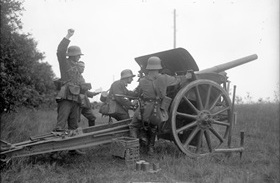GERMANY EXITS LEAGUE OF NATIONS
Berlin, Germany • October 14, 1933
On this date in 1933 German Chancellor Adolf Hitler announced that his country was pulling out of the League of Nations, predecessor to today’s United Nations. Germany had been a League member since 1926. Hitler, who had been in office less that nine months, had recently asked the League for “equality of status”—meaning he wanted the League to grant Germany the right to build up its military to a level equal to those of the other major powers. Under the terms of the 1919 Treaty of Versailles, which brought World War I to an end, the German Reichswehr (army) was unable to grow past 100,000 men, while oddly enough Hitler’s political party, the Nazis, had a paramilitary force of several million storm troopers, members of the Sturmabteilung (Storm Battalion), commonly known by the initials “SA.” The Nazi Party’s brownshirted private army was led by Hitler acolyte Ernst Roehm, a captain in Kaiser Wilhelm’s army and in the Weimar Republic’s Reichswehr. (Roehm’s paramilitary had played a key role in Hitler’s unsuccessful Beer Hall Putsch in Munich, Bavaria’s capital, in November 1923.)
When League members predictably refused to budge on the question of equality status for Germany’s armed forces, Hitler made the announcement to pull out of the international organization to the delight of most Germans, who wanted to shake off, as he explained in a “rant” to American ambassador William Dodd on October 17, the indignities a victimized Germany had faced at the hands of the victors of the past world war. (Besides a shrunken military, the 1919 peace treaty required Germany and her co-belligerents to accept responsibility for causing “all the loss and damage” the war had inflicted on the victorious Allied powers and to pay 132 billion Reichmarks (equivalent to 442 billion U.S. dollars in 2017) in reparations to the winners.) Dodd, a former history professor, told a suddenly quiet Hitler that war is always followed by injustice, and pointed to the example of the North’s “terrible” treatment of the Southern states after the U.S. Civil War. Hitler just stared back at the ambassador before changing the subject.
Cunningly, Hitler told his countrymen that they would decide the League issue in a plebiscite set for November 12, 1933, a date chosen because it was one day after the fifteenth anniversary of the armistice that brought the Great War to an end. With Hitler’s Nazi Party controlling the media and his storm troopers standing outside polling places, the outcome was never in doubt.
Once again in 1933 the German electorate ratified Chancellor Hitler’s leadership and “democratically” granted him his wish to withdraw Germany from the League of Nations and embark on a new, ambitious, and aggressive course for his nation of 66 million people. In 1935 Hitler introduced military conscription, enabling the German Army to annually train 300,000 conscripts, who, since August 1934, swore direct allegiance to Hitler rather than to “the People and the Fatherland.” By 1939 the German armed forces (renamed the Wehrmacht in 1935) had nearly 100 divisions of 1.5 million well-trained men and close to 8,300 military aircraft available to assault neighboring Poland in the opening salvo by Hitler’s war machine to dominate all of Europe.
![]()
![]()
German Reichswehr, 1930–1933
 |  |
Left: On January 1, 1921, Weimar President Friedrich Ebert officially established the German Reichswehr pursuant to the limitations imposed by the 1919 Treaty of Versailles. The Reichswehr was limited to a standing army of 100,000 men and a navy of 15,000. In this photograph, Ebert’s successor, Paul von Hindenburg (out of camera range), reviews a parade march of Reichswehr soldiers in 1930.
![]()
Right: This photo depicts Reichswehr soldiers manning a machine gun in a military exercise near Frankfurt on the Oder in September 1930. Observing the exercise was Col. Gen. Wilhelm Haye, Chef der Heeresleitung (Chief of the Army Command) from 1926 to October 1930. Under Hitler the office would be called Oberkommando des Heeres. The Versailles Treaty forbade the establishment of a general staff with oversight over the army and navy. In 1938 Hitler created the Oberkommando der Wehrmacht (Supreme Command of the Armed Forces), headed by Field Marshal Wilhelm Keitel, who signed the German Instrument of Surrender on May 8, 1945, in Berlin.
 |  |
Left: Heavy weapons such as artillery above the caliber of 105mm (for naval guns, above 205mm), armored vehicles, tanks, submarines, and capital ships were forbidden under the Versailles Treaty, as were aircraft of any kind. Compliance with these restrictions was monitored until 1927 by a mixed commission of specialists from the United States, Great Britain, France, Italy, and Japan. In this June 1931 photo an artillery unit practices firing shells.
![]()
Right: This December 1930 photo depicts a Reichswehr mortar unit during an exercise.
Germany Exits League of Nations (Contemporary footage. Skip first 10 seconds)
![]()

 History buffs, there is good news! The Daily Chronicles of World War II is now available as an ebook for $4.99 on Amazon.com. Containing a year’s worth of dated entries from this website, the ebook brings the story of this tumultuous era to life in a compelling, authoritative, and succinct manner. Featuring inventive navigation aids, the ebook enables readers to instantly move forward or backward by month and date to different dated entries. Simple and elegant! Click
History buffs, there is good news! The Daily Chronicles of World War II is now available as an ebook for $4.99 on Amazon.com. Containing a year’s worth of dated entries from this website, the ebook brings the story of this tumultuous era to life in a compelling, authoritative, and succinct manner. Featuring inventive navigation aids, the ebook enables readers to instantly move forward or backward by month and date to different dated entries. Simple and elegant! Click 











